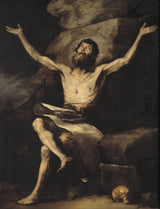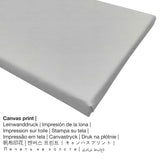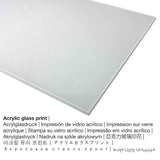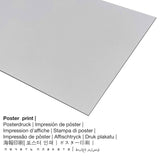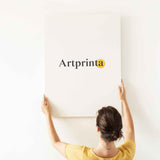Workshop of Jusepe de Ribera, 1644 - St Paul the Hermit - fine art print
Tax included. Shipping calculated at checkout.
Your personal visual art copy
St Paul the Hermit is a work of art by Workshop of Jusepe de Ribera in 1644. The beyond 370 year-old original has the following size: Height: 208 cm (81,8 ″); Width: 157 cm (61,8 ″) Framed: Height: 232 cm (91,3 ″); Width: 186 cm (73,2 ″); Depth: 9 cm (3,5 ″). Today, the work of art is included in the Nationalmuseum Stockholm's digital art collection - the museum is Sweden's museum of art and design, a Swedish government authority with a mandatet o preserve cultural heritage and promote art, interest in art and knowledge of art. With courtesy of: Nationalmuseum Stockholm & Wikimedia Commons (license: public domain).The creditline of the artpiece is: . Moreover, alignment is in portrait format and has a side ratio of 3 : 4, which means that the length is 25% shorter than the width.
Pick your product material
In the dropdown menu next to the product you can pick your favorite material and size. You can choose among the following product customization options:
- The canvas print: A UV printed canvas material mounted on a wooden frame. It has the particular impression of three-dimensionality. A canvas print of this artwork will allow you to transform your custom fine art print into a large size artpiece like you know from galleries. Hanging your canvas print: The great advantage of canvas prints is that they are relatively low in weight. This means, it is easy to hang the Canvas print without the support of extra wall-mounts. Hence, canvas prints are suited for any type of wall.
- Printed poster (canvas material): A poster print is a printed canvas with a granular surface texture, that resembles the actual version of the work of art. Please keep in mind, that depending on the absolute size of the poster we add a white margin of around 2-6cm round about the print motif to facilitate the framing with your custom frame.
- Printed acrylic glass: The print on acrylic glass, often denoted as a print on plexiglass, will convert your favorite original work of art into lovely home décor. Further, it forms a great alternative to canvas or aluminium dibond art prints. With a glossy acrylic glass art print sharp contrasts and painting details become more visible because of the precise tonal gradation.
- Metal print (aluminium dibond): Aluminium Dibond prints are metal prints with a true effect of depth. The white & bright components of the original artwork shine with a silk gloss, however without the glow.
Important information: We try everything in order to describe the art products as closely as possible and to display them visually. Although, some pigments of the print materials and the imprint may diverge somehwat from the image on your screen. Depending on the settings of your screen and the condition of the surface, not all color pigments will be printed as realisitcally as the digital version depicted here. Given that all are printed and processed manually, there might as well be slight deviations in the size and exact position of the motif.
The product specifications
| Product categorization: | wall art |
| Reproduction method: | digital reproduction |
| Manufacturing process: | digital printing |
| Provenance: | German production |
| Stock type: | production on demand |
| Intended product usage: | wall décor, wall gallery |
| Orientation of the image: | portrait alignment |
| Aspect ratio: | 3 : 4 - (length : width) |
| Side ratio interpretation: | the length is 25% shorter than the width |
| Available product fabrics: | poster print (canvas paper), acrylic glass print (with real glass coating), metal print (aluminium dibond), canvas print |
| Canvas on stretcher frame (canvas print): | 30x40cm - 12x16", 60x80cm - 24x31", 90x120cm - 35x47", 120x160cm - 47x63" |
| Acrylic glass print (with real glass coating) variants: | 30x40cm - 12x16", 60x80cm - 24x31", 90x120cm - 35x47", 120x160cm - 47x63" |
| Poster print (canvas paper) size variants: | 30x40cm - 12x16", 60x80cm - 24x31", 90x120cm - 35x47" |
| Aluminium dibond print (aluminium material) sizes: | 30x40cm - 12x16", 60x80cm - 24x31", 90x120cm - 35x47" |
| Framing of the art reproduction: | without frame |
Structured information on the piece of art
| Title of the painting: | "St Paul the Hermit" |
| Categorization: | painting |
| General category: | classic art |
| Temporal classification: | 17th century |
| Created in: | 1644 |
| Artwork age: | around 370 years |
| Original artwork dimensions: | Height: 208 cm (81,8 ″); Width: 157 cm (61,8 ″) Framed: Height: 232 cm (91,3 ″); Width: 186 cm (73,2 ″); Depth: 9 cm (3,5 ″) |
| Museum / location: | Nationalmuseum Stockholm |
| Museum location: | Stockholm, Stockholm County, Sweden |
| Website: | Nationalmuseum Stockholm |
| License type of artwork: | public domain |
| Courtesy of: | Nationalmuseum Stockholm & Wikimedia Commons |
The painter
| Artist name: | Workshop of Jusepe de Ribera |
| Artist nationality: | Spanish |
| Professions: | painter |
| Country: | Spain |
| Artist category: | old master |
| Age at death: | 61 years |
| Born: | 1591 |
| Birthplace: | Xàtiva |
| Died in the year: | 1652 |
| Place of death: | Naples |
© Copyright protection, Artprinta.com (Artprinta)
General description from the museum's website (© - by Nationalmuseum Stockholm - Nationalmuseum Stockholm)
English: Paul of Thebaid was considered the first of the hermits of Egypt – men and women who, to escape persecution as Christians in the 3rd century, chose a life of solitude for the sake of contemplation and asceticism. According to tradition, Paul remained in the desert for almost ninety years, wearing only a garment of woven palm leaves and subsisting on fruit and bread. Edifying images of the hermits’ lives, expressing the value of penitence, were popular subjects in counter-reformation art. Ribera’s portrayal demonstrates a rare understanding of Caravaggio’s lesson. The depicted moment represents the story’s emotional climax, Paul’s ecstatic vision and mystic communion with God, symbolised by the light. The saint’s pose, with its reference to the crucified Christ, indicates his willingness to heed Christ’s call to follow him. His emaciated body is rendered with intransigent realism, every anatomical defect scrupulously transcribed. This stands in sharp contrast to the intense spirituality that radiates from his face. By working with a live model, the artist created an intensely human hero, a modern Saint Paul, and thus established an accessible role model for the faithful to emulate. Paulus av Thebe ansågs vara den förste av de egyptiska eremiterna – kvinnor och män som för att undkomma förföljelsen av kristna på 200-talet valde ett liv i avskildhet och ägnade sig åt kontemplation och askes. Enligt traditionen tillbringade Paulus nästan nittio år i öknen, där han endast iklädd ett plagg av vävda palmblad livnärde sig på frukt och bröd. Som uttryck för botens sakrament hade motreformationens bilder på de tidigkristna eremiterna ett uppbyggligt syfte. Riberas gestaltning av botgöraren visar en djup insikt i Caravaggios konst. Ögonblicket utgör berättelsens känslomässiga klimax, där ljuset får symbolisera Paulus extatiska uppenbarelse och inre dialog med Gud. Hans pose anspelar på den korsfäste Kristus och antyder beredvillighet att lyssna till kallelsen att följa honom. Den utmärglade kroppen är avbildad med en orubblig realism och varje anatomisk ofullkomlighet är noggrant återgiven. Detta i kontrast till anletet som utstrålar andlighet. Genom att måla efter levande modell skapar konstnären bilden av en djupt mänsklig karaktär, en modern S:t Paulus, som erbjuder den troende en förebild att identifiera sig med.

